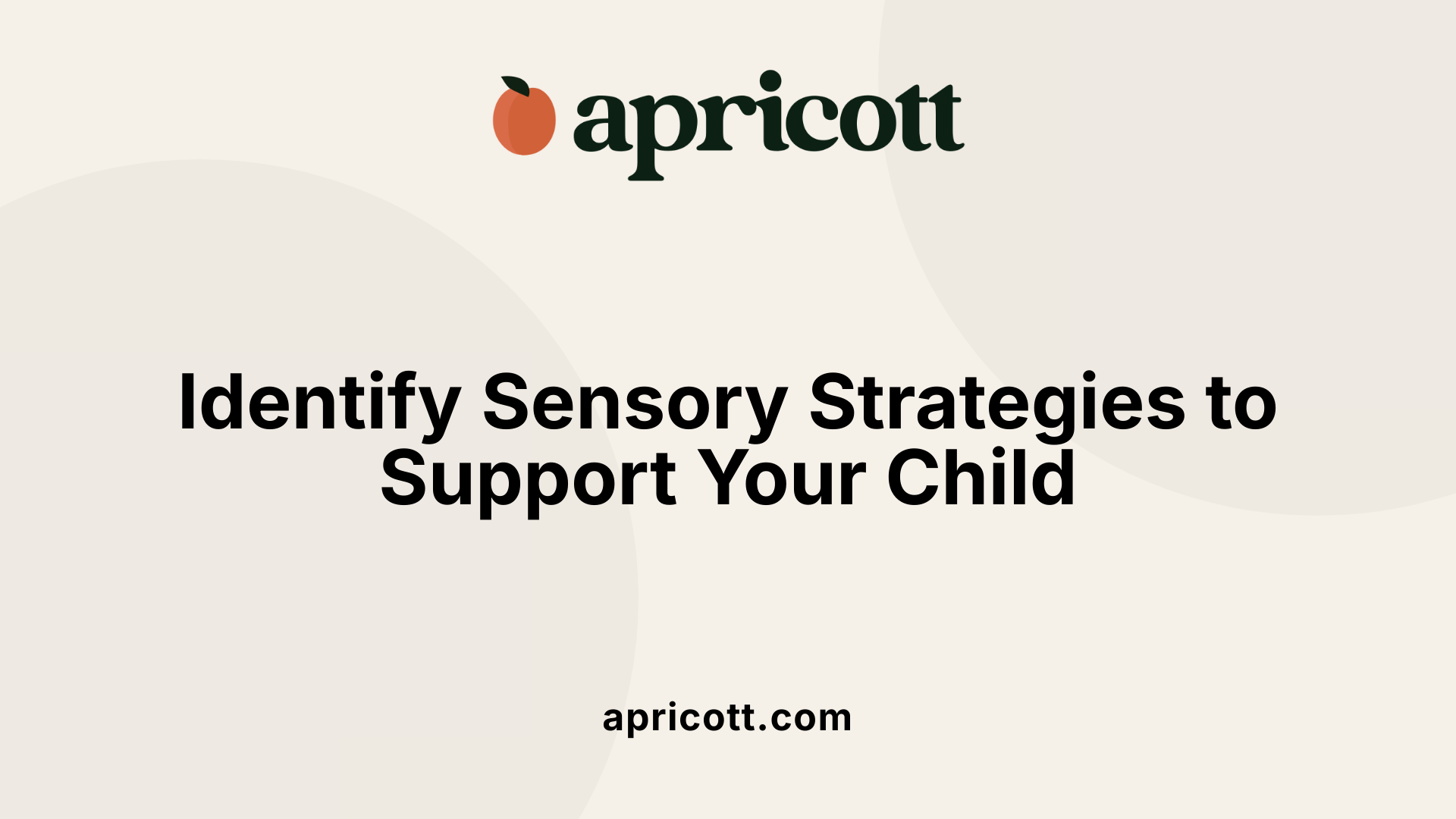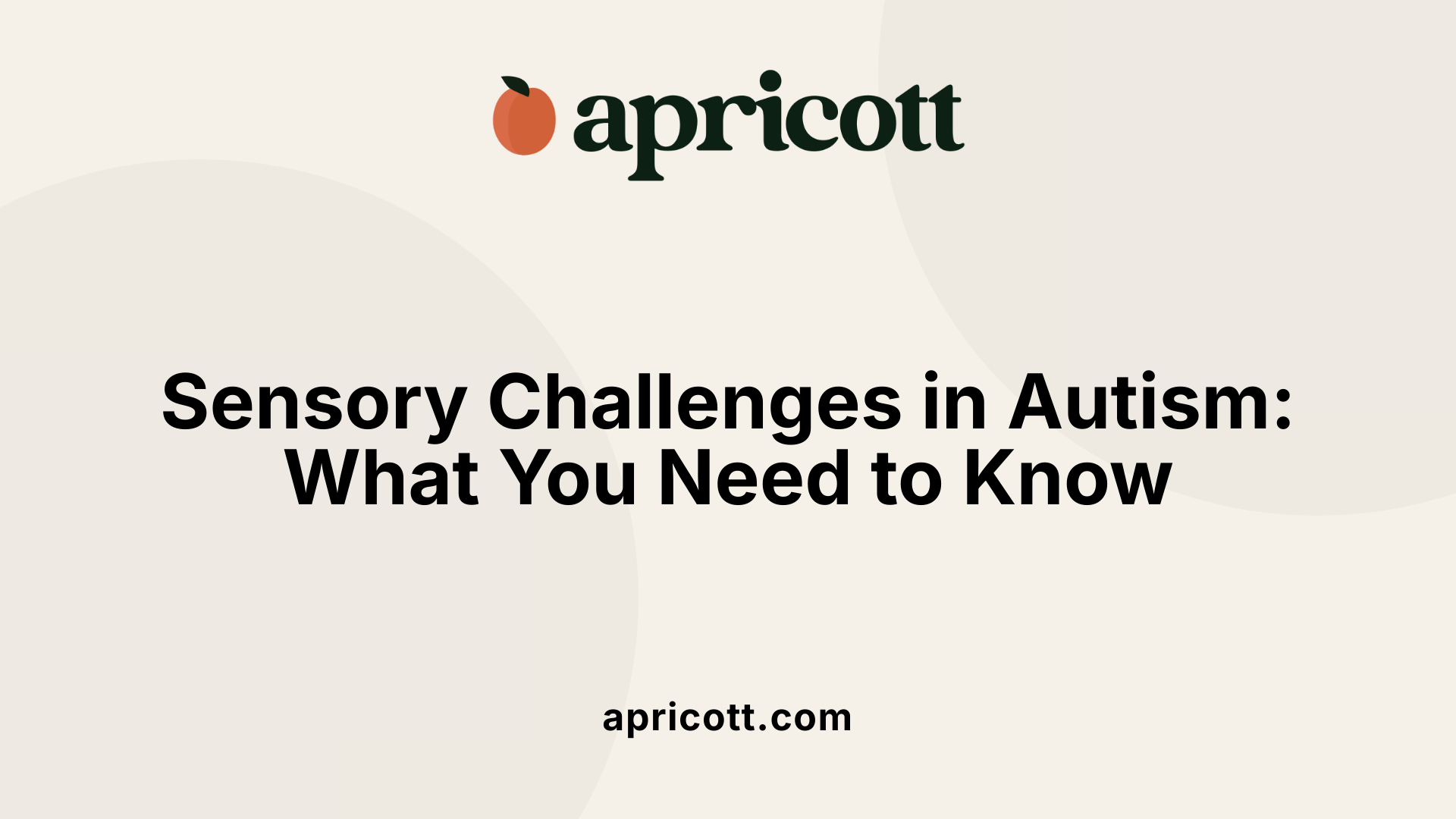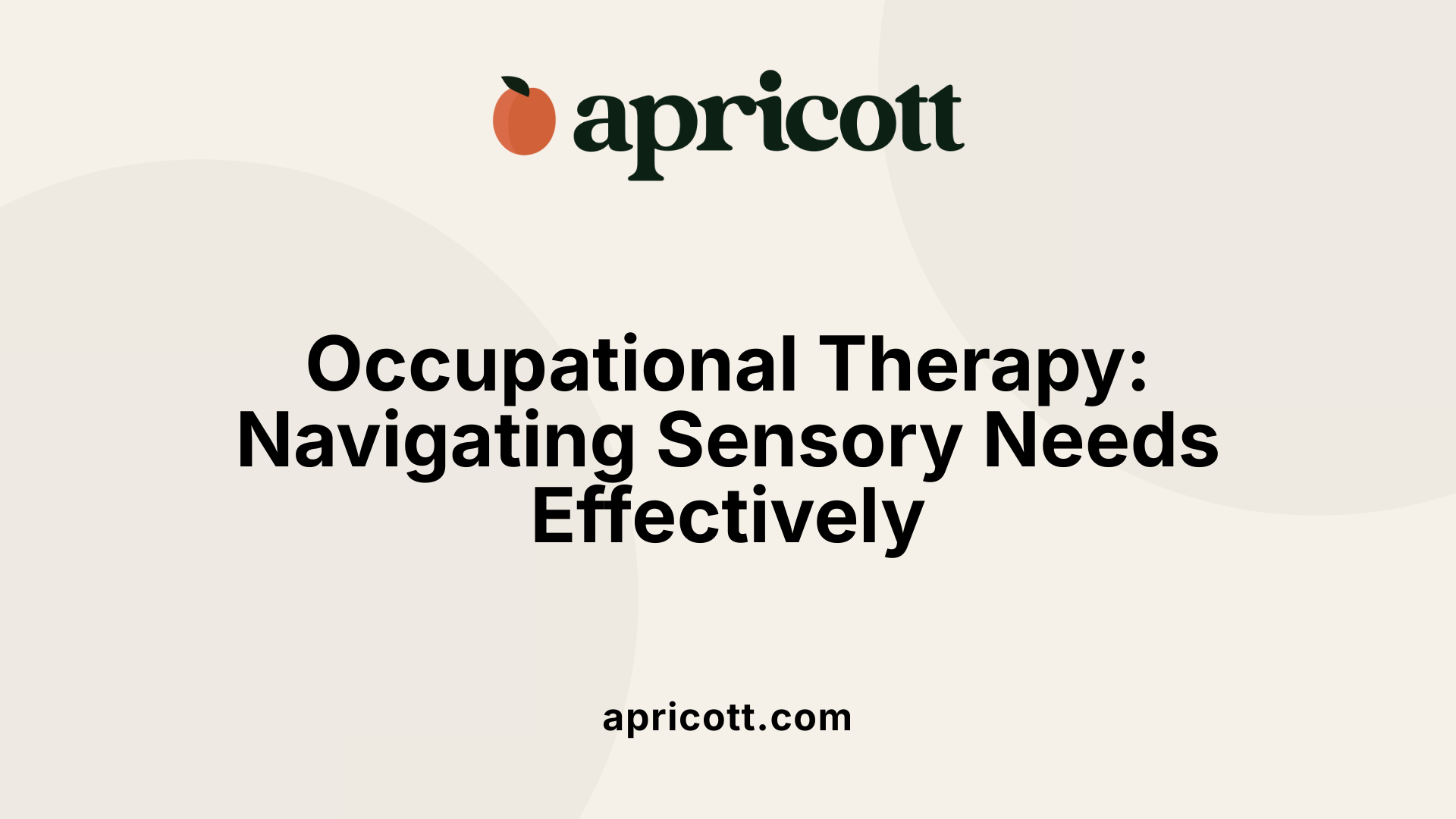December 2, 2025
Understanding Sensory Processing Challenges in Children with Autism
Children exhibiting sensory seeking or sensory avoiding behaviors face unique challenges that can impact their daily lives, especially those on the autism spectrum. This article explores the nuances of sensory processing differences, therapeutic interventions like sensory integration and Applied Behavior Analysis (ABA), and strategies to support children's sensory needs effectively.

Sensory seeking behaviors occur when children have a reduced sensitivity to sensory inputs, referred to as hyposensitivity. These children actively crave additional stimuli to satisfy their sensory needs. Examples include making loud noises, constant touching of objects or people, rocking back and forth, or an affinity for bright lights and vivid colors. On the other hand, sensory avoiding behaviors stem from hypersensitivity, where children experience an over-responsiveness to certain sensory stimuli. This often leads to withdrawal or active avoidance of specific sights, sounds, textures, or smells.
Children with sensory seeking tendencies often display repetitive movements, such as rocking or banging objects, and may seek intense physical sensations through activities like rough play. Conversely, children exhibiting sensory avoiding behaviors may cover their ears in response to loud noise, pull away from touch, or reject particular foods or clothing textures. These behaviors serve as coping strategies to manage overwhelming sensory experiences.
Sensory sensitivities can affect multiple sensory domains including:
Children who are sensory seekers may frequently stim by rocking, spinning, or making repetitive sounds to generate needed sensory input. Those who are sensory avoiders might exhibit behaviors such as rapid speech or silence, covering ears or eyes, rejecting foods, or experiencing shutdowns and meltdowns due to sensory overload. Recognizing these signs can help caregivers and professionals provide appropriate support and accommodations to improve day-to-day functioning.

Sensory processing challenges are extremely common in children diagnosed with autism spectrum disorder, affecting approximately 90% to 95% of this population. These difficulties involve how the brain receives, processes, and interprets sensory information from the environment as well as from internal sensory systems like proprioception and interoception.
Sensory sensitivities are officially recognized as part of the diagnostic criteria for ASD. Individuals with autism can experience hypersensitivity (over-responsiveness) or hyposensitivity (under-responsiveness) or a mix of both across multiple senses, including sight, sound, touch, balance, smell, and taste. This sensory aspect is therefore a fundamental element considered when diagnosing and understanding autism.
These sensory processing differences can significantly impact daily life, contributing to challenges in communication, social interactions, and engagement in routine activities. Hypersensitivity may cause children to avoid certain stimuli, like bright lights or loud noises, while hyposensitivity can lead to behaviors seeking more intense sensory input, such as rocking or making sounds. This mix often results in sensory overload, anxiety, or meltdowns, which affect how comfortably and successfully children function at home, school, and community settings.
It is common for autistic individuals to experience both hypersensitive and hyposensitive sensory responses simultaneously. For example, a child might be highly sensitive to sound yet seek strong proprioceptive input through movement or pressure. This combination creates a complex sensory profile that requires personalized strategies and interventions to help manage symptoms effectively and improve quality of life.

Sensory integration therapy aims to help children with sensory processing challenges reach an optimal level of arousal and self-regulation. The goal is to "rewire" the brain to improve how sensory information is processed, leading to better sensory responses and reduced anxiety in everyday situations.
Occupational therapists use targeted techniques such as specific movement activities, resistive body work, and skin brushing methods like the Wilbarger protocol. These approaches support children exhibiting sensory defensiveness (over-responsiveness) or sensory cravings (under-responsiveness) to achieve more balanced sensory experiences.
Treatment often takes place in sensory gyms specially designed to provide controlled sensory input. Common features include swings, weighted vests, ball pits, and squeeze machines that deliver calming deep pressure. These environments allow children to engage safely in sensory activities tailored to their individual needs.
An essential part of therapy involves training parents to continue sensory support at home through a "sensory diet" or "sensory lifestyle." This includes creating quiet spaces, using sensory tools like weighted blankets and fidget toys, and incorporating calming or alerting activities regularly to help maintain sensory regulation outside clinical settings.

Occupational therapists employ targeted methods to help children manage sensory processing challenges. These include resistive body work, where gentle but firm pressure is applied to the body to enhance sensory integration. Another notable technique is skin brushing, such as the Wilbarger protocol, which uses specific brushing patterns to reduce sensory defensiveness and craving behaviors. These approaches aim to normalize the child’s sensory responses by gently stimulating the nervous system.
Treatment often takes place in specially designed sensory gyms. These environments are equipped with items like weighted vests that provide calming deep pressure, ball pits that encourage proprioceptive input, and squeeze machines that offer gentle compression. Such equipment helps regulate a child's sensory arousal levels by providing controlled sensory experiences tailored to their needs.
The central goal of occupational therapy in sensory processing is to help children achieve an optimal state of arousal. This means they can be alert and engaged without being overwhelmed or under-stimulated. By promoting better sensory regulation, therapy can reduce anxiety and improve a child’s interaction with their environment, facilitating smoother functioning at school and home.
A vital aspect of therapy is training parents to carry out supportive interventions at home. Known as a 'sensory diet' or 'sensory lifestyle,' this involves creating quiet spaces and using sensory tools such as weighted blankets and fidget toys. Parents learn how to integrate sensory activities throughout daily routines, reinforcing the progress made in therapy and supporting their child’s ongoing development.
Applied Behavior Analysis (ABA) therapy is a scientifically supported approach designed to assist individuals with autism by applying principles of learning and behavior. At its core, ABA relies on the Antecedent-Behavior-Consequence (A-B-C) model, which helps therapists understand what triggers certain behaviors (antecedent), observe the behavior itself, and analyze the results or outcomes (consequence). This framework enables customized interventions that promote desirable behaviors and reduce challenging ones.
ABA therapy involves various techniques tailored to develop essential skills such as communication, social interaction, self-care, and academic abilities. Methods like positive reinforcement encourage desired actions by rewarding them, while discrete trial training breaks down tasks into smaller, manageable steps. Naturalistic teaching approaches embed learning into everyday activities, making skill acquisition more accessible and relevant.
Crucially, ABA is not a fixed program; interventions are continuously monitored and modified by trained professionals to fit the individual's evolving needs. This flexibility ensures that the therapy supports autonomy and improves the quality of life, while respecting personal preferences and endorsing a strengths-based perspective.
By systematically understanding and shaping behavior, ABA therapy offers a structured, evidence-based method to empower individuals with autism to thrive in various aspects of their lives.
ABA therapy is delivered by a coordinated team of professionals, each with distinct roles to ensure effective treatment. The primary providers include Board Certified Behavior Analysts (BCBAs), Registered Behavior Technicians (RBTs), and Board Certified Assistant Behavior Analysts (BCaBAs).
BCBAs typically hold a graduate-level degree in behavior analysis or a related field. They are certified professionals responsible for developing individualized treatment plans, overseeing therapy implementation, and supervising paraprofessionals. Their training emphasizes ethical conduct and evidence-based strategies tailored to meet individual needs.
RBTs, on the other hand, are paraprofessionals who have completed at least 40 hours of specialized coursework along with competency assessments. They deliver direct one-on-one interventions under the close supervision of BCBAs, ensuring that therapy is administered consistently and safely.
BCaBAs serve as intermediaries; they usually have a bachelor's degree and are certified to assist BCBAs in implementing treatment plans and supervising RBTs. They provide valuable support by bridging the gap between clinical planning and practical application.
This team-based approach allows for comprehensive and ethical delivery of ABA therapy, with each member playing a crucial role in promoting positive outcomes for individuals with autism and related developmental needs.
ABA (Applied Behavior Analysis) therapy offers substantial benefits for individuals with sensory and behavioral challenges, especially for children with autism spectrum disorder (ASD). Families can expect improvements in communication skills, social interactions, and daily living abilities such as dressing, toileting, and self-care. By focusing on positive reinforcement and skill-building in real-life contexts, ABA helps children reduce sensory seeking and avoidance behaviors that often disrupt their daily routines.
ABA therapy targets functional communication and social abilities, helping children express needs effectively and engage more fully with others. This includes fostering joint attention, turn-taking, and understanding social cues. Gradually, children gain independence in daily living tasks, which enhances their confidence and participation in everyday activities.
Sensory processing difficulties can manifest as either hypersensitivity or hyposensitivity, leading to behaviors like stimming, sensory avoidance, or sensory seeking. ABA uses tailored strategies to reduce these challenging behaviors by teaching adaptive responses and self-regulation techniques, resulting in improved emotional regulation and decreased anxiety.
ABA therapy involves families as active partners, equipping them with practical strategies to continue reinforcing skills at home. This empowerment enables caregivers to support their child's progress consistently, manage challenging behaviors effectively, and create a supportive environment.
Early and consistent ABA intervention has been linked to meaningful developmental progress. Over time, children develop greater independence, improved social functioning, and enhanced quality of life. Families report that these gains translate into better school participation and more positive social relationships.
| Benefit Area | Description | Impact on Individuals and Families |
|---|---|---|
| Communication and Social Skills | Enhanced ability to communicate and engage socially | Improved interactions and relationships |
| Daily Living Skills | Increased independence in tasks like dressing and toileting | Greater self-confidence and autonomy |
| Behavioral Regulation | Reduced sensory seeking and avoiding behaviors | Lower anxiety and better emotional control |
| Family Involvement | Caregiver education and support | Consistent reinforcement and stress reduction |
| Long-term Development | Progressive gains over time | Enhanced overall functioning and quality of life |
ABA (Applied Behavior Analysis) therapy has been subject to significant criticism, particularly regarding its historical use of intensive and sometimes aversive methods. Early practices sometimes involved punitive approaches aimed at suppressing behaviors deemed undesirable, which could lead to emotional distress for the individual and a failure to respect authentic autistic behaviors. This has raised ethical concerns about the imposition of normalization, potentially disregarding the value of neurodiversity.
In response, modern ABA approaches have evolved to emphasize person-centered, positive, and naturalistic methods. Contemporary therapists aim to promote autonomy, well-being, and skill development while honoring the individuality of autistic people. These refined practices seek to avoid harmful or distressing interventions.
However, despite these advances, some challenges persist. Accessibility and cost remain significant barriers, as many families struggle to obtain comprehensive therapy due to limited availability or high expenses. Additionally, ensuring the therapy is delivered respectfully and ethically—aligned with the individual's unique sensory needs and preferences—requires ongoing professional training and awareness.
Overall, critiques of ABA underline the importance of evolving practices that prioritize ethical considerations and embrace the neurodiversity paradigm, while addressing systemic issues related to therapy availability and affordability.
Sensory overload happens when intense or too much sensory input overwhelms a person, making it hard for them to process their surroundings. For children, especially those with autism, this can result from sudden, loud noises, bright or flickering lights, strong smells, or a buildup of various sensory stimuli over time. When overloaded, children might feel anxious, want to escape the situation, or find it difficult to communicate clearly.
Stimming refers to repetitive movements or sounds that many autistic individuals use to manage their sensory experiences. This can include rocking, hand-flapping, or making noises. These actions help them regulate their sensory system, relieve stress, and stay calm. It is important to understand that stimming serves a vital purpose; suppressing it can lead to greater sensory overload or emotional burnout.
Children facing sensory challenges often show behaviors such as increased movement or fidgeting, frequent stimming, rapid or unusually quiet speech, and covering their ears or eyes to block out stimuli. They might reject certain foods or types of clothing due to texture sensitivities, engage in excessive chewing or rough play, or display signs of shutdowns and meltdowns when overwhelmed.
When overwhelmed by sensory input, children may struggle to express themselves or communicate their needs effectively. This sensory overload can heighten anxiety and frustration, leading to challenges in social settings like school or home. Emotional well-being is impacted too, as continued sensory difficulties may cause stress or feelings of isolation. Understanding and accommodation can greatly improve these experiences and support better regulation.
Children with sensory hypersensitivity often react strongly to light, sound, and touch. To help manage these sensitivities, accommodations include using light covers to soften harsh lighting, earplugs or noise-cancelling headphones to reduce auditory input, and quiet spaces designed to provide calm and reduce sensory overload. Adjusting schedules to avoid crowded or noisy times can also minimize distress.
For children who experience sensory under-responsiveness, interventions focus on sensory seeking behaviors. Using deep pressure tools like weighted vests or blankets can provide calming proprioceptive input. Movement breaks involving swings, ball pits, or resistive activities help fulfill the need for vestibular and proprioceptive stimulation, enabling better focus and regulation.
Creating sensory-friendly environments is critical. At home, parents can establish quiet zones with minimal distractions and incorporate calming sensory tools like fidget toys or squeeze machines. Similarly, schools can offer sensory corners, schedule flexibility, and access to calming equipment to support children’s regulation and participation.
Teaching children to understand and communicate their sensory needs is vital. Self-advocacy involves recognizing personal triggers and preferences, trying different sensory tools, and collaborating with caregivers and educators. Resources such as the Self-Empowerment Roadmap and Employment Toolkit offer guidance for developing these skills. Encouraging self-awareness and communication helps children feel supported and more in control of their sensory experiences.
Parents play a crucial role in managing sensory and behavioral challenges for children with sensory processing issues and autism spectrum disorder (ASD). They are often trained to implement sensory diets or a sensory lifestyle at home, which includes activities like creating quiet spaces and using sensory tools such as weighted blankets and fidget toys. These strategies help children regulate sensory input and maintain emotional balance throughout the day.
Maintaining predictable routines and minimizing environmental clutter and noise are vital for providing children with stability and reducing sensory overload. Visual cues and schedules help children anticipate daily activities, decreasing anxiety and improving engagement. Sensory corners designed with calming tools and weighted objects offer safe spaces where children can retreat to manage sensory sensitivities and self-regulate effectively.
Collaboration between parents, occupational therapists, speech therapists, behavioral specialists, and support groups ensures that interventions are well-coordinated and personalized to the child's needs. This teamwork fosters a comprehensive understanding of each child's sensory profiles and behavioral patterns, enabling the sharing of practical strategies and emotional support for families.
Holistic care integrates sensory integration therapy, occupational therapy, speech therapy, cognitive behavioral therapy, and educational and psychological interventions. Combining these therapies allows addressing sensory challenges alongside communication, social interaction, and behavioral needs. This multifaceted approach enhances children’s ability to function in diverse settings such as home, school, and community environments.
Parents empowered with knowledge, collaborating closely with professionals, and applying consistent sensory strategies help create environments where children with sensory processing issues and autism can thrive.
Understanding sensory seeking and sensory avoiding behaviors is crucial in effectively supporting children, particularly those with autism spectrum disorder. Combining therapies such as sensory integration and Applied Behavior Analysis with accommodations and family collaboration can greatly enhance a child's ability to regulate sensory input, develop vital skills, and improve quality of life. Advocacy, education, and ethical practices remain key to respecting individual sensory needs and fostering inclusive environments where all children can thrive.